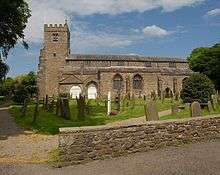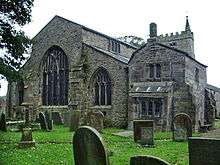St Helen's Church, Churchtown
| St Helen's, Churchtown | |
|---|---|
 St. Helen's Church in 2009 | |
 St Helen's, Churchtown Location in the Borough of Wyre | |
| Coordinates: 53°52′44″N 2°47′24″W / 53.8788°N 2.7900°W | |
| OS grid reference | SD 4816242798 |
| Location | Churchtown, Lancashire |
| Denomination | Anglican |
| Website |
sthelens-stmichaels |
| History | |
| Dedication | St Helen |
| Architecture | |
| Functional status | Active |
| Heritage designation | Grade I |
| Designated | 17 April 1967 |
| Specifications | |
| Height | 62 feet (19 m) |
| Administration | |
| Parish | Garstang St Helen |
| Deanery | Garstang |
| Archdeaconry | Blackburn |
| Diocese | Blackburn |
| Province | York |
| Clergy | |
| Vicar(s) | Rev Andrew Wilkinson |
| Assistant | Rev Constance Whalley |
St Helen's Church is an Anglican church in the village of Churchtown in Lancashire, England. Historically, it was the parish church of Garstang; today, as Garstang is split into more than one ecclesiastical parish, St Helen's parish is Garstang St Helen (Churchtown). It is in the Diocese of Blackburn. It has been designated a Grade I listed building by English Heritage. St Helen's is known as the "cathedral of The Fylde".[1]
History
St Helen's is situated close to the banks of the River Wyre.[2] Historically, the village of Churchtown (once known as Kirkland) was part of the ecclesiastical parish of Garstang, with St Helen's as the parish church.[2] The oldest parts of the church date from the 13th century, these are the piers and responds in the chancel, and the arch piers in the nave.[2] The church was rebuilt in the 15th and 16th centuries.[2] In 1736, an overflow of the River Wyre flooded the churchyard and damaged the church, necessitating its restoration.[2] In 1811 the roofs were replaced, the walls were raised and a clerestory added.[3] Further restoration work took place in 1866–1869 by E. G. Paley at a cost of £1,372 (equivalent to £110,000 in 2015).[4][5]
St Helen's is one of only two Grade I listed buildings in the Borough of Wyre[6] and includes:
- a "lepers' window" or "squint";
- a grave marker for the village's only victim of the Black Plague;
- a large rafter, once known as the "new beam", supposedly presented to the parish by King Henry VIII at the time of the Reformation.
The circular churchyard with several yew trees point to its original use as a Druid temple. It was believed by some that the area may have been the site where Christian missionaries from Ireland first set foot in Lancashire at the end of the navigational portion of the River Wyre which flows to the Irish Sea some 14 miles away.
Assessment and administration
It was designated a Grade I listed building by English Heritage on 17 April 1967.[7] The Grade I designation—the highest of the three grades—is for buildings "of exceptional interest, sometimes considered to be internationally important".[8]
An active church in the Church of England, St Helen's is part of the Diocese of Blackburn, which is in the Province of York. It is in the archdeaconry of Blackburn and the Deanery of Garstang. In shares a benefice with St Michael's Church in St Michael's on Wyre. The official name of the parish is Garstang St Helen (Churchtown).[9] St Helen's is known as the "cathedral of The Fylde".[1][10]
Architecture
Exterior

St Helen's is constructed in the Perpendicular style of rubble with ashlar dressings.[2][3] Its plan consists of a clerestoried nave with aisles to the north and south, a chapel and porch to the south, a tower to the west, and a chancel, which has north and south aisles and a north vestry.[2] The roofs are low-pitched.[2] The chapel and aisles have a plain ashlar parapet.[2]
The west tower has six stages.[2] It has angled buttresses on the west side and a crenellated parapet.[7] There is a turret on its north-east corner, which has a spire.[3] The belfry louvres have trefoiled two-light openings with square heads.[3] There is also a small, square window at the level of the bell-ringing chamber.[2] The north wall of the tower has a clock.[2]
Interior and fittings
Internally, the tower measures 11 feet (3.4 m) square.[2] It is entered from the nave through an arch of two hollow chamfered orders.[2] The nave measures 55 feet 6 inches (16.92 m) by 21 feet 9 inches (6.63 m).[2] It is separated from the north and south aisles by five-bay arcades, with pointed arches and round piers.[3][7] There is a recumbent effigy in the nave to Alexander Butler (d. 1726).[3] The Lady chapel south of the south aisle, endowed by Lady Rigmayden of Wedacre in 1529, is accessed through two pointed arches.[7] It was founded by Margaret Rigmaiden (d. 1516) of Wedacre.[1] The chapel contains a piscina (basin), which has a cusped head.[3] On the wall there is an inscription in Latin warning of "idle chatter in church".[3]
The chancel measures 36 feet 9 inches (11.20 m) by 19 feet 3 inches (5.87 m).[2] The pointed chancel arch separating the chancel from the nave is in the Decorated style; it has two orders with wave moulding.[2][3] The vestry at the north-east corner of the building is mostly constructed of dressed stone, which contrasts with the rubble of the rest of the church.[1]
The stained glass in the church dates mostly from the 19th century. It includes work by Ward and Hughes, William Wailes and Heaton, Butler and Bayne.[3] The tower houses a ring of six bells hung in a wooden frame, that are rung from the ground floor.[11] They were cast in 1828 by Thomas Mears at the Whitechapel Bell Foundry in London.[12]
Churchyard

The churchyard is mostly to the north and south sides of the church.[2] It contains several sandstone headstones that have received a Grade II designation from English Heritage. They date mostly from the 18th century.[nb 1] There is a sundial that dates from 1757.[2] South of the church there is the chamfered shaft of a sandstone cross, probably dating from the Middle Ages. North-east of the church is a stone cross. The base is from the Middle Ages, but the shaft and octagonal steps were replaced in the 1930s. The whole cross and the incomplete cross shaft have also been given Grade II listings.[22][23]
See also
- Listed buildings in Kirkland, Lancashire
- Grade I listed buildings in Lancashire
- Grade I listed churches in Lancashire
- List of ecclesiastical works by E. G. Paley
References
- Notes
- Footnotes
- 1 2 3 4 Bilsborough, p. 56
- 1 2 3 4 5 6 7 8 9 10 11 12 13 14 15 16 17 18 19 Farrer & Brownbill (1912), pp. 291–300
- 1 2 3 4 5 6 7 8 9 10 Hartwell & Pevsner (2009), pp. 358–59
- ↑ UK CPI inflation numbers based on data available from Gregory Clark (2016), "The Annual RPI and Average Earnings for Britain, 1209 to Present (New Series)" MeasuringWorth.
- ↑ Brandwood et al. 2012, p. 222.
- ↑ "Listed Buildings". Wyre Borough Council. Retrieved 5 June 2015.
- 1 2 3 4 "Church of St Helen", National Heritage List for England, English Heritage, retrieved 18 June 2011
- ↑ "Listed Buildings", National Heritage List for England, English Heritage, retrieved 18 June 2011
- ↑ "Church Details: Garstang St Helen (Churchtown)", blackburn.anglican.org, Diocese of Blackburn, retrieved 4 May 2011
- ↑ "History of Wyre — Churchtown", wyrebc.gov.uk, Wyre Borough Council, retrieved 18 June 2011
- ↑ Cheetham (1919), pp. 46–47
- ↑ "Garstang, Churchtown — S Helen", Dove's Guide for Church Bell Ringers, 28 March 2007, retrieved 18 June 2011
- ↑ "Group of 2 Headstones Against East Wall of Vestry of Church of St. Helen", National Heritage List for England, English Heritage, retrieved 18 June 2011
- ↑ "Group of 6 Headstones Against South Wall of South Chapel of Church of St. Helen", National Heritage List for England, English Heritage, retrieved 18 June 2011
- ↑ "Headstone Against East Wall of South Chapel of Church of St. Helen", National Heritage List for England, English Heritage, retrieved 18 June 2011
- ↑ "Headstone East of Vestry of Church of St. Helen", National Heritage List for England, English Heritage, retrieved 18 June 2011
- ↑ "Headstone North-east of Vestry of Church of St. Helen", National Heritage List for England, English Heritage, retrieved 18 June 2011
- ↑ "Headstone North-east of Vestry of Church of St. Helen", National Heritage List for England, English Heritage, retrieved 18 June 2011
- ↑ "Headstone North of Vestry of Church of St. Helen", National Heritage List for England, English Heritage, retrieved 18 June 2011
- ↑ "Headstone North of Church of St. Helen", National Heritage List for England, English Heritage, retrieved 18 June 2011
- ↑ "Group of 8 Headstones North of Church of St. Helen", National Heritage List for England, English Heritage, retrieved 18 June 2011
- ↑ "Cross Shaft South of Church of St. Helen", National Heritage List for England, English Heritage, retrieved 19 June 2011
- ↑ "Cross North-East of Church of St. Helen", National Heritage List for England, English Heritage, retrieved 19 June 2011
- Bibliography
- Bilsborough, Norman (1989), The Treasures of Lancashire, North West Civic Trust, ISBN 0-901347-41-8
- Brandwood, Geoff; Austin, Tim; Hughes, John; Price, James (2012), The Architecture of Sharpe, Paley and Austin, Swindon: English Heritage, ISBN 978-1-84802-049-8
- Cheetham, F. H. (1919), The Church Bells of Lancashire [Part 4: The Hundred of Amounderness], Sherratt & Hughes, OCLC 27475286
- Farrer, William; Brownbill, J., eds. (1912), "The Parish of Garstang", A History of the County of Lancaster: Volume 7, retrieved 8 October 2010
- Hartwell, Clare; Pevsner, Nikolaus (2009) [1969], Lancashire: North, New Haven and London: Yale University Press, ISBN 0-300-12667-0
External links
 Media related to St Helen's Church, Churchtown at Wikimedia Commons
Media related to St Helen's Church, Churchtown at Wikimedia Commons- "St Helen, Churchtown" at genuki.org.uk
- "St Helen's - Catherdral of the Fylde, Garstang" at achurchnearyou.com